Tangy, crunchy, and probiotic, this homemade sauerkraut recipe is the perfect gut-friendly condiment! Otherwise the same as my no-pound recipe, this kraut is made in a stoneware crock for the ultimate in big batch fermenting. I’ve included my best ferment troubleshooting tips and a free video to walk you through the fermentation process!
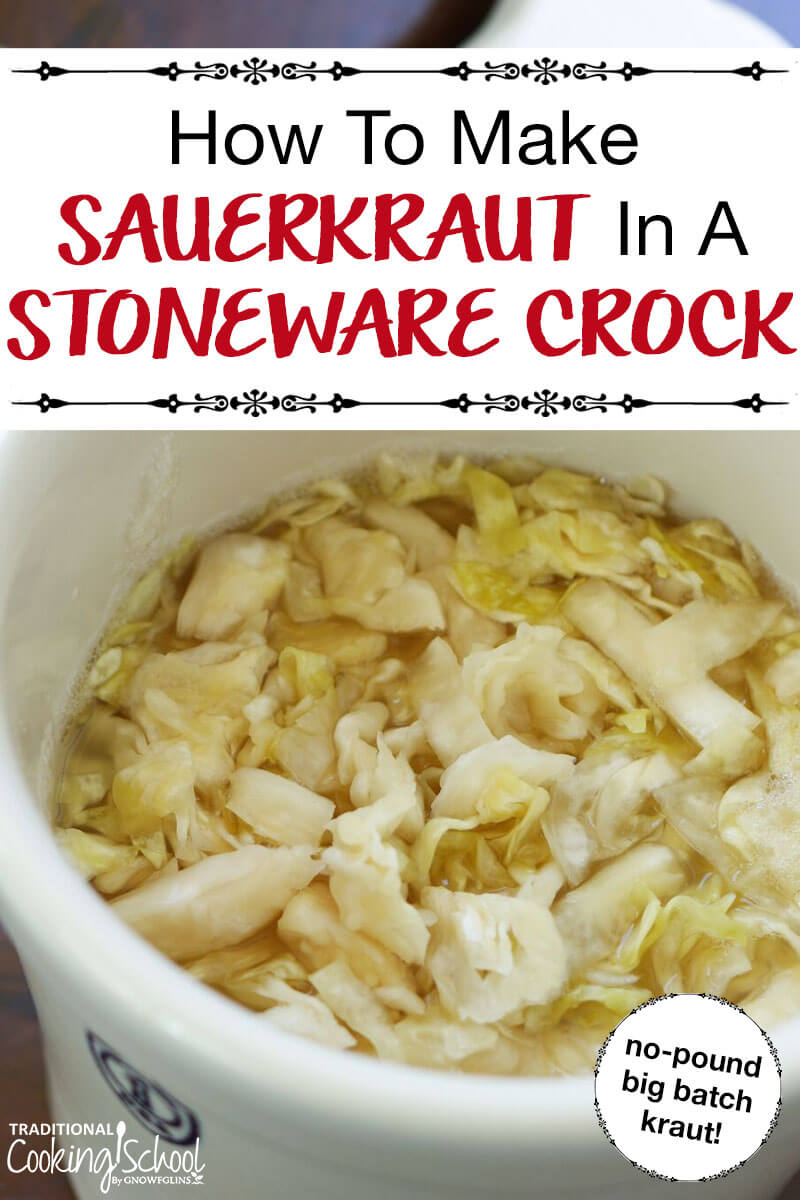
Want to make homemade sauerkraut in a stoneware crock?
It’s a super fun and beautiful process!
Not to mention, it’s the ultimate in batch cooking because you’re making a whole bunch at a time in a big, beautiful crock.
At our house, we have both a 1-gallon and 3-gallon crock from Ohio Stoneware. I feel such satisfaction when I fill them up with sauerkraut or other fermented foods.
And of course… we enjoy the health benefits of those fermented foods. The probiotics in sauerkraut are oh-so-good for the gut. Just a few tablespoons of the juice with a meal is the best digestive aid around. (No more antacid tablets!)
I could eat gobs of kraut… and making it in a crock ensures that we have plenty around. 🙂 This is the sauerkraut we use to make Grandma Mabel’s Sauerkraut & Spare Ribs.
Ready to make some together?
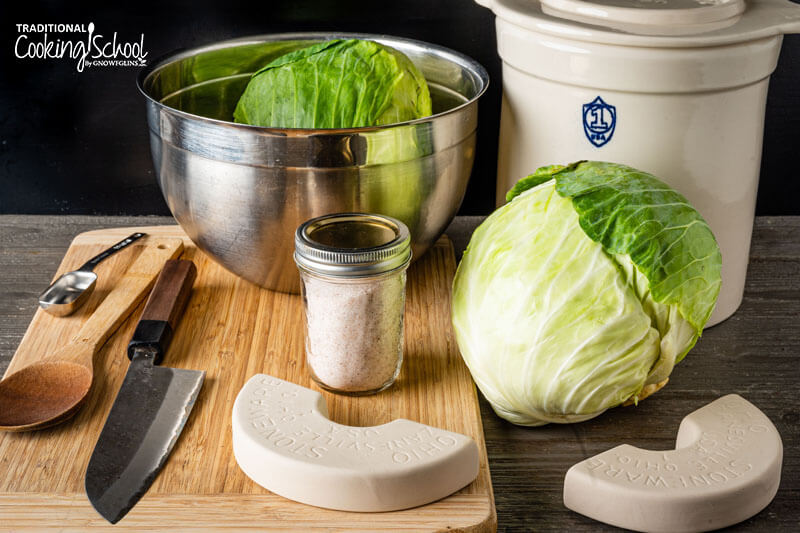
Table Of Contents
Ingredients
- Cabbage – Choose organic whenever possible. They will not only be more healthy and contain more nutrition overall, but organic farming disallows the use of pesticides which would otherwise interfere with the fermentation.
- Sea salt – We recommend unrefined, fine-grain sea salt such as this ancient sea salt from Redmond Real Salt. Don’t use standard table salt. It has added iodine and anti-caking agents. The iodine is antimicrobial and can prevent a good fermentation.
Best Fermenting Vessels
Special thanks to Ohio Stoneware for supplying the 1-gallon crock I used for the video. Their USA-made products are fantastic and affordable. In addition to the style I used in the video, they also have larger traditional style crocks with a water gutter to keep them air-tight (we have a 3 gallon size of that style). You can follow my instructions for this no-pound sauerkraut for smaller quart-jar/mason jar quantities.
You can follow the recipe below with any fermenting container(s). Glass jars or bowls are best; avoid plastic, as the acids in the fermented foods may leech plastic into your food.
However, if you want to do it in a stoneware fermentation crock as I’ve done, here are the supplies you need:
- Complete 1-gallon kit from Ohio Stoneware — includes crock, weights, and lid
- 1-gallon crock from Ohio Stoneware
- Lid for 1-gallon crock from Ohio Stoneware
- Prepper Pro (optional; helps pack the cabbage down into the crock tightly)
- Ohio Stoneware weights for 1-gallon crock
Homemade Sauerkraut Directions
Notice the finished texture of my batch of sauerkraut, above. It should be salty, sour, crunchy, with a yellowed color. Keep an eye out for these characteristics when you follow the directions below.
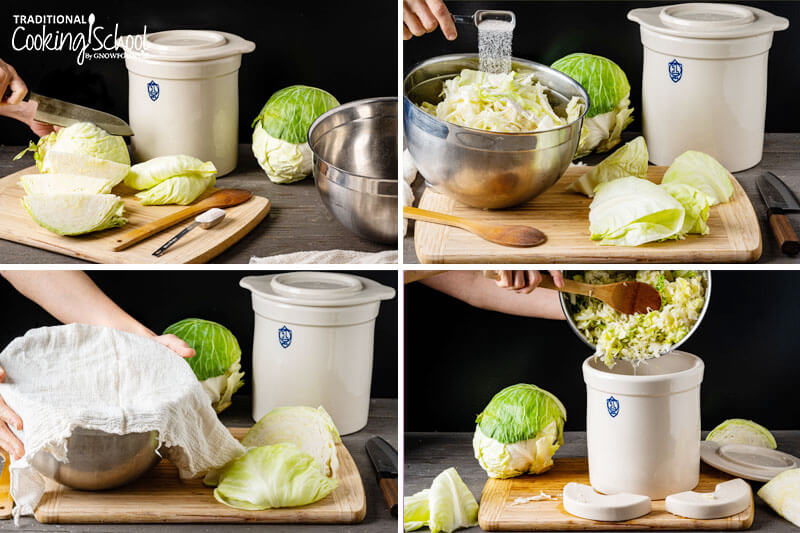
1. Combine the shredded cabbage (or thinly sliced cabbage) and sea salt in a large bowl. Stir. Taste and ensure it tastes pleasant but a bit on the salty side.
2. Cover the bowl with cheesecloth or a light cloth and let it sit for 30 minutes or an hour to get juicy. (The salt will begin pulling moisture out of the cabbage.)
3. Using the Prepper Pro or another utensil, pack well into a clean 1-gallon crock to 2/3 or 3/4 full.
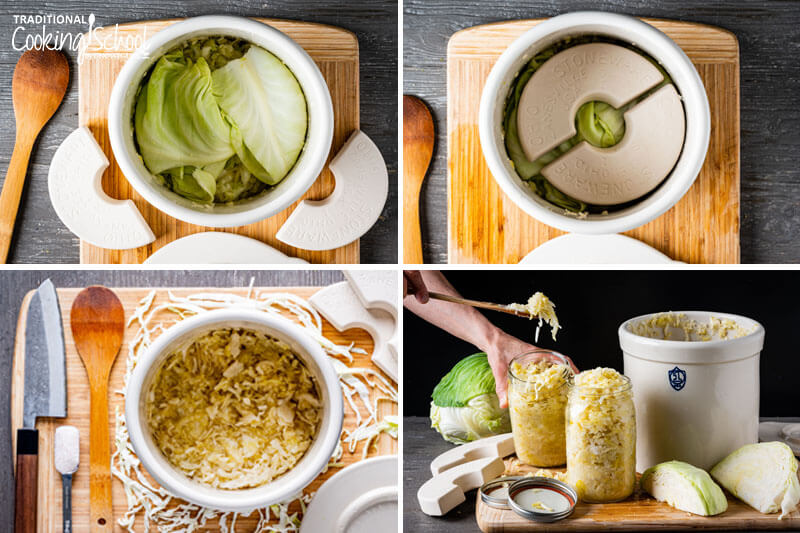
4. Place a few cabbage leaves on the top of the mixture, followed by the weights. Then put the lid on the crock.
5. Let ferment at room temperature (about 72 degrees Fahrenheit) for 5 to 10 days.
6. Check inside the crock a few times in the first 24 hours to ensure that the cabbage has released enough juice to keep the sauerkraut completely submerged. If cabbage mixture has lifted in jar and has created air pockets in the mixture, pack it back down. Skim off any mold or fuzz that develops on top (everything beneath the brine should be fine).
7. The fermentation process may proceed faster at warm temperatures or if cabbage pieces are small. The mixture will be bubbly, and the vegetables will soften. Stop the fermentation when you like the flavor and texture. (We like ours best with a fermentation time of about 5 to 7 days.)
8. Move the entire crock to a refrigerator or cold storage, or transfer to smaller jars first.
9. Ensure the sauerkraut is submerged in brine even in cold storage to avoid unwanted bacteria from forming. If it ever goes dry, add salt water or kraut juice from another batch until all fermented cabbage is covered.
10. You can eat right away or let it age more in cold storage. Repack well each time you get in and out of the container. Enjoy!
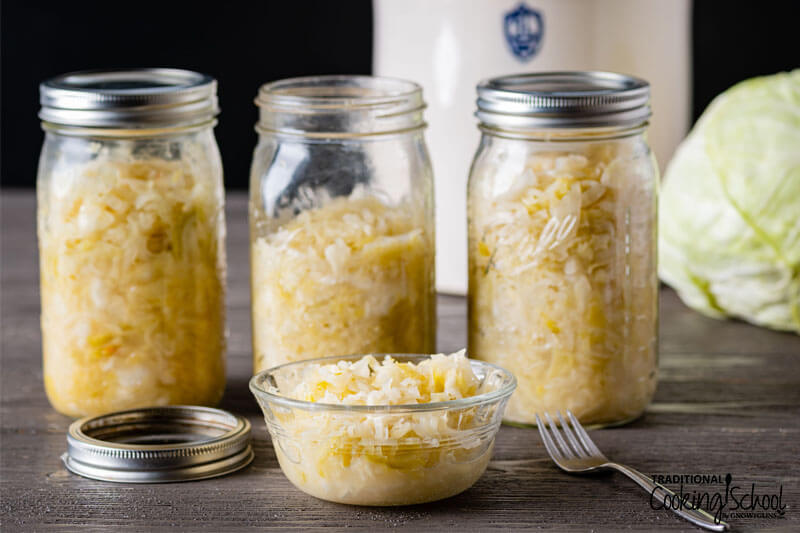
Sauerkraut FAQs
If you’re new to lacto-fermentation, it can be intimidating. Is it safe? Will your kraut spoil? Here are some tips to boost your confidence and help you stay on the right track.
My sauerkraut doesn’t have enough liquid to submerge the mixture, even after 24 hours. What should I do?
Tamp the mixture down as far as it will go. Dissolve 1 teaspoon of a mineral-rich salt into 1/2 cup of pure, uncontaminated water, and pour to cover.
My sauerkraut is producing way too much liquid — it leaked and spilled everywhere. What should I do?
It is a good idea to keep a towel under the jar in case of liquid leaking out. If the mixture does leak, open the jar and remove some cabbage (but not juice if you can help it) to lessen the volume in the jar.
My sauerkraut won’t stay down. What should I do?
Every day, tamp it back down to release the air bubbles lifting the mixture up. You want to keep it submerged. Feel free to use fermenting weights to help, or even half of an apple wedged down into the jar to keep the mixture covered by brine.
Help! I don’t see any bubbles in my sauerkraut.
Look for other signs of fermentation, such as texture changes, color changes and the whole mixture starting to develop sourness from the lactic acid that’s produced. If you’re seeing these signs, all is well. If you’re not, is your ferment kept in a warm enough place to allow the beneficial bacteria to thrive?
I think I see mold in/on my sauerkraut. Is it safe to eat if I skim it away, or should I toss the whole thing?
It depends. Please reference this post for preventing mold during fermentation, and what to do if it happens.
How can I tell if my homemade sauerkraut is spoiled or not?
Trust your nose! Though be aware that if it repels you but is not spoiled, it might be because you’re unaccustomed to fermented foods and need time to adjust to a new normal. If you aren’t sure, you can take a little taste and see how it goes. It’s always OK to be on the safe side and compost the ferment or feed the chickens with it.
Check out this #AskWardee for the signs that your ferment is on the right track. And here are hard and fast signs that a ferment has gone wrong:
- It’s moldy. Pink or fuzzy is not good.
- It’s mushy.
- Its smell repels you because it’s putrid or rotten, not just sour. Your nose KNOWS this!
- When you taste it, it gives you an upset stomach. (Don’t confuse this with a healing reaction, though.)
Any time you get into a jar, repack it carefully to keep all food submerged and under protection of brine.
How can I tell if my sauerkraut is done?
Go ahead and open it up and smell and taste it! No two ferments are going to be exactly alike — this is a flexible process and you really have to open the jar and dig in to see what’s going on in there. I discuss the typical signs of a finished ferment in this article.
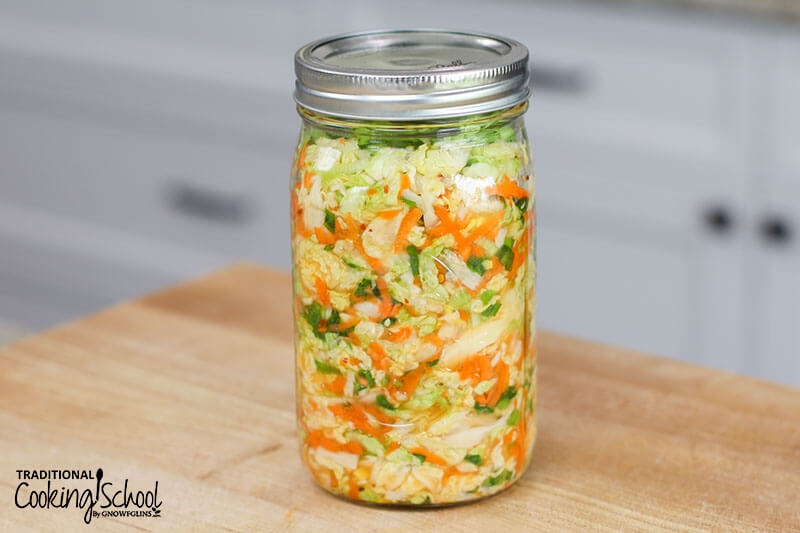
Other Fermented Vegetable Recipes
- Simple, No-Pound Sauerkraut
- High Vitamin C Sauerkraut
- Homemade Kimchi: An Easy Korean Sauerkraut Recipe(pictured above)
- Old-Fashioned, Crunchy, Fermented Garlic-Dill Pickles
- Lacto-Fermented Carrot Sticks
- Lacto-Fermented Turnips & Beets
- 5-Spice Apple Chutney {lacto-fermented!}
- Spontaneously Fermented Sparkling Apple Cider {fall’s easiest ferment!}
- Homemade Raw Apple Cider Vinegar Recipe
- Fermenting Trouble Shooting FAQ’s
Do you make fermented foods in crocks? Please share your tips in the comments! And please give us a rating on the recipe card below. Then snap a photo of your homemade sauerkraut and tag us on social media!
In the video, I mentioned my FREE Fermenting Formulas Cheat Sheet — it’s a gift from me to you. Here’s a link to that.
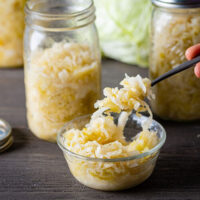
Homemade Sauerkraut In A Stoneware Crock
You'll love making sauerkraut at home in your stoneware crock! The probiotics in sauerkraut are oh-so-good for the gut. Just a few tablespoons of the juice with a meal is the best digestive aid around. Makes approximately 1 gallon.
Ingredients
- 5 pounds fresh organic cabbage - shredded (reserve a few clean outer leaves)
- 3 tablespoons sea salt
Instructions
-
Combine the shredded cabbage and sea salt in a big bowl. Stir. Taste and ensure it tastes like salty cabbage -- still pleasant but a bit on the salty side.
-
Cover the bowl with cheesecloth or a light cloth and let it sit for 30 minutes or an hour to get juicy. (The salt will begin pulling moisture out of the cabbage.)
-
Pack well into a clean 1-gallon crock to 2/3 or 3/4 full. (I use the Prepper Pro to pack the cabbage down tightly.)
-
Place cabbage leaves on the top of the mixture, followed by the weights. Then put the lid on the crock. Let ferment at room temperature (about 72 degrees Fahrenheit) for 5 to 10 days.
-
Check inside the crock a few times in the first 24 hours to ensure that the cabbage has released enough juice to rise above the cabbage leaves by about an inch (so the sauerkraut is completely submerged).
-
In about a week, check the sauerkraut to see if it's done. It should be salty, sour, crunchy and transformed from cabbage to kraut! (See video above for texture example.)
-
Move the entire crock to a refrigerator or cold storage. If it's too big, transfer the kraut to smaller jars that will fit your cold space.
-
Ensure the sauerkraut is submerged in brine even in cold storage. If it ever goes dry, add salt water or kraut juice from another batch.
-
You can eat right away or let it age more in cold storage.
-
Repack well each time you get in and out of the container.
-
Enjoy!
Recipe Notes
The fermentation process may proceed faster at very warm temperatures or if cabbage pieces are small. If cabbage mixture has lifted in jar and has created air pockets in the mixture, press the mixture back down to remove air holes. Skim off any mold or fuzz that develops on top (everything beneath the brine should be fine).
Free Fermenting Formulas Cheat Sheet
If you like this, then you’ll love my Free Fermenting Formulas Cheat Sheet.
It’s a free gift for you. It’s where I share formulas for all kinds of ferments, beverages and salsa and kraut and pickles and relish, oh yes. So you can create your own safe to eat, delicious, yummy, healthy, fermented foods.
This post was featured in 60 Easy and Nourishing Picnic Recipes and 39 Nourishing Postpartum Freezer Meals To Prepare While You’re Pregnant.
This post was originally published and written by Wardee Harmon on 8/23/16. It was updated and republished on 4/28/21.
We only recommend products and services we wholeheartedly endorse. This post may contain special links through which we earn a small commission if you make a purchase (though your price is the same).



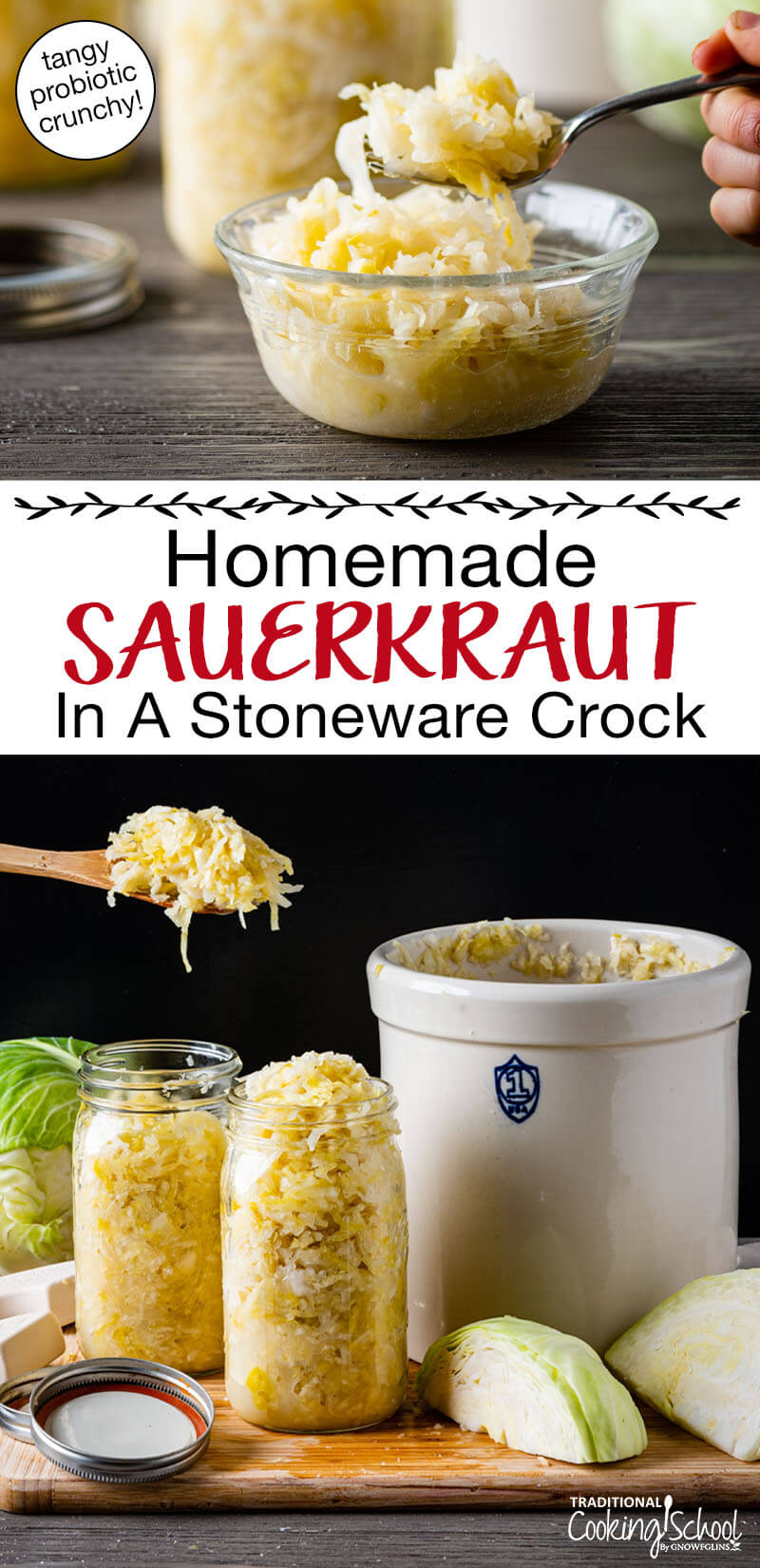
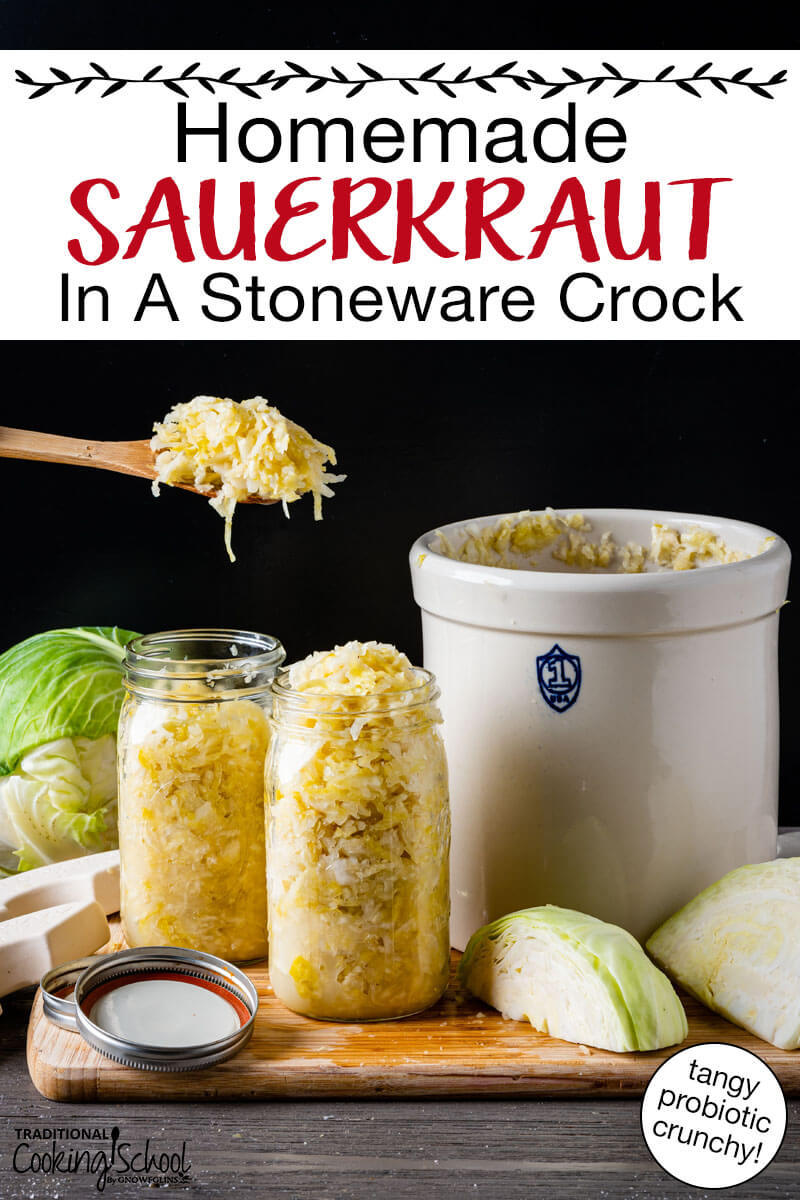
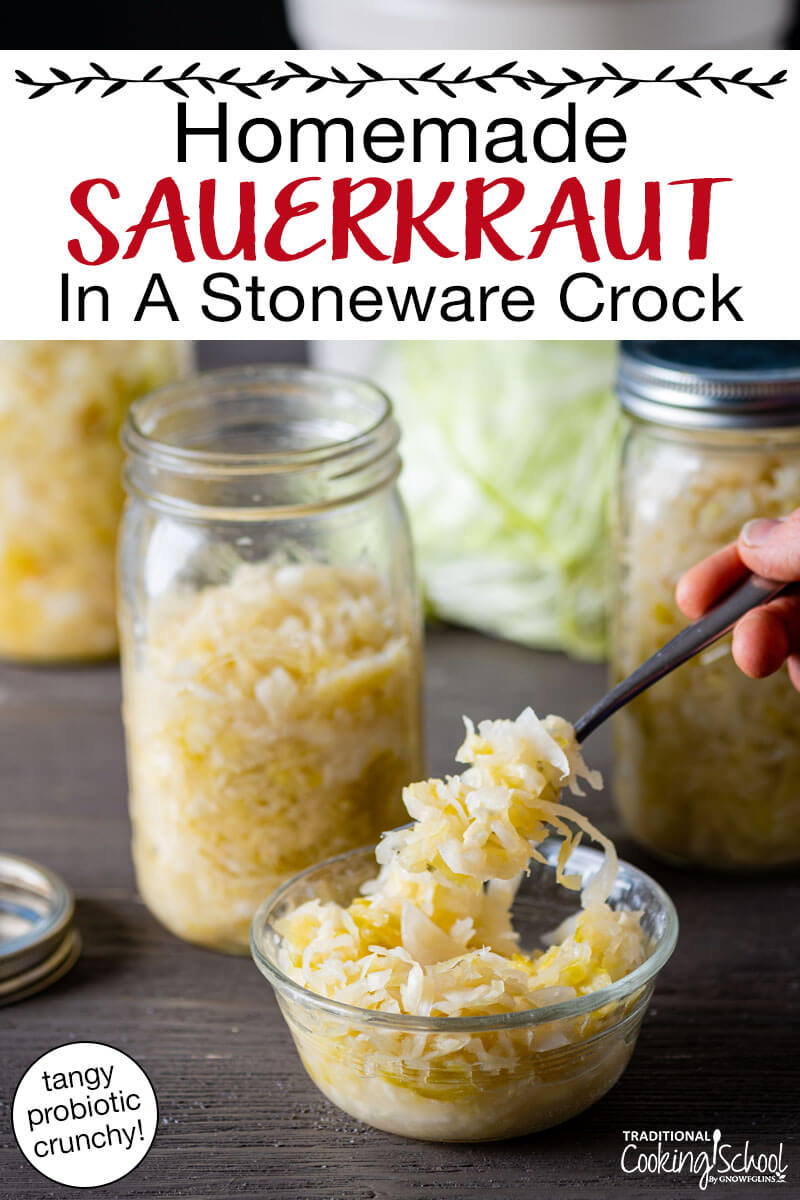
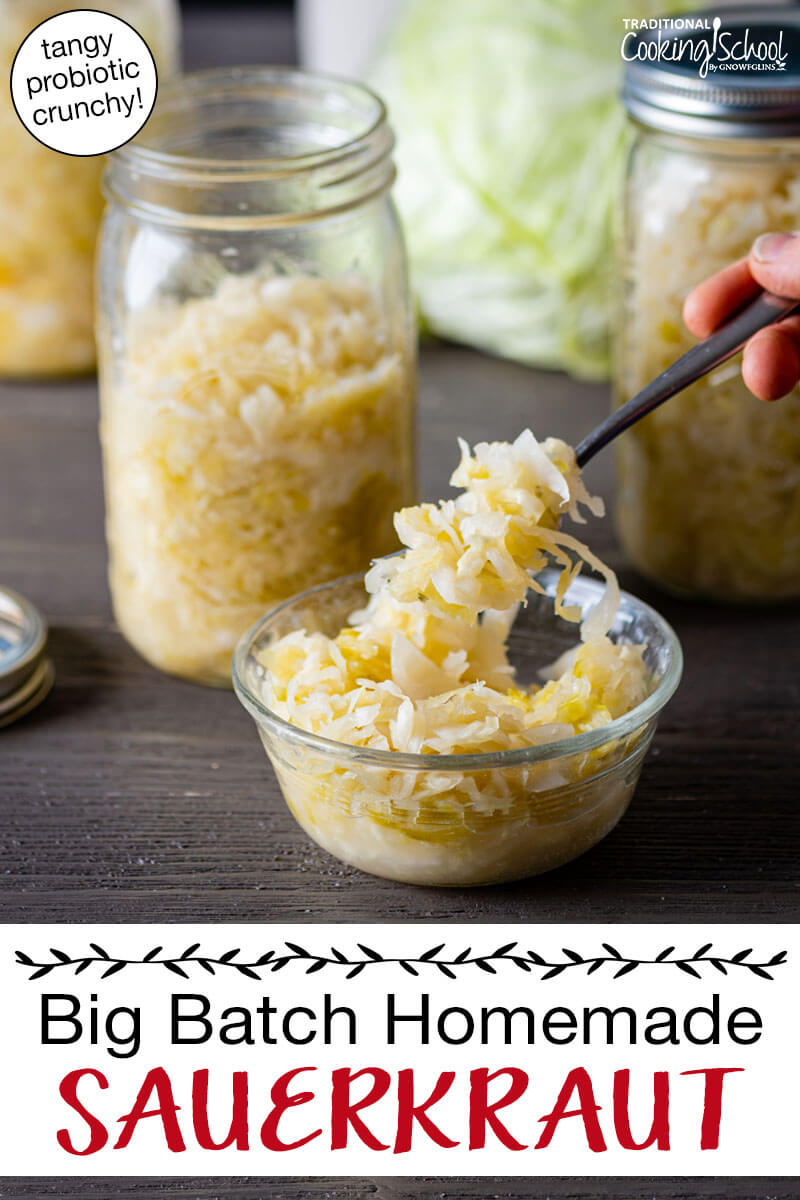
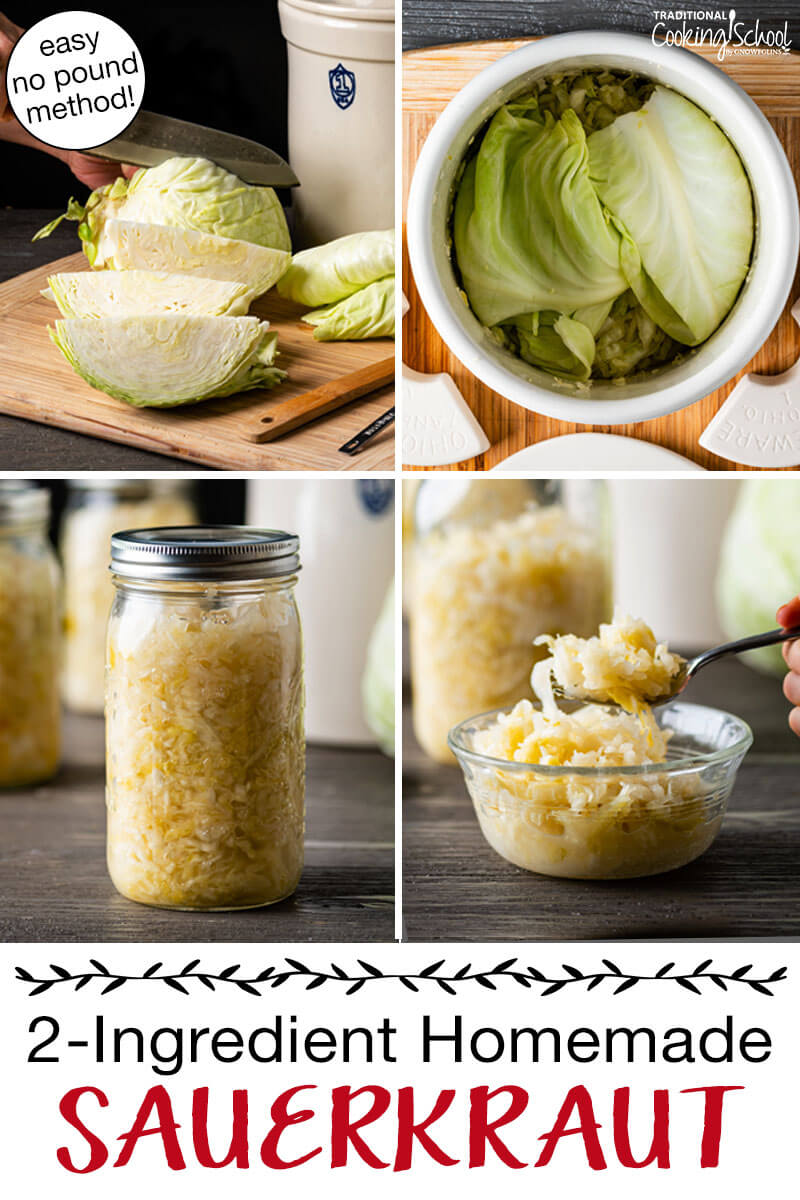

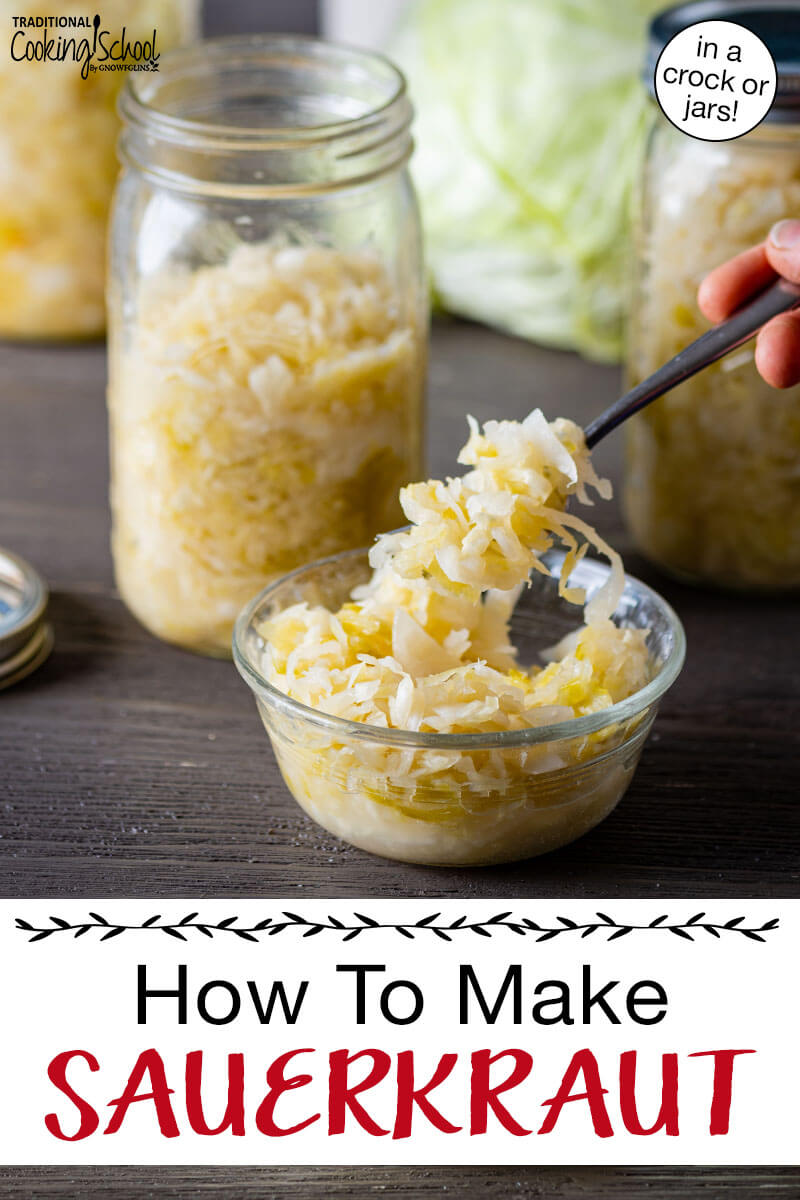
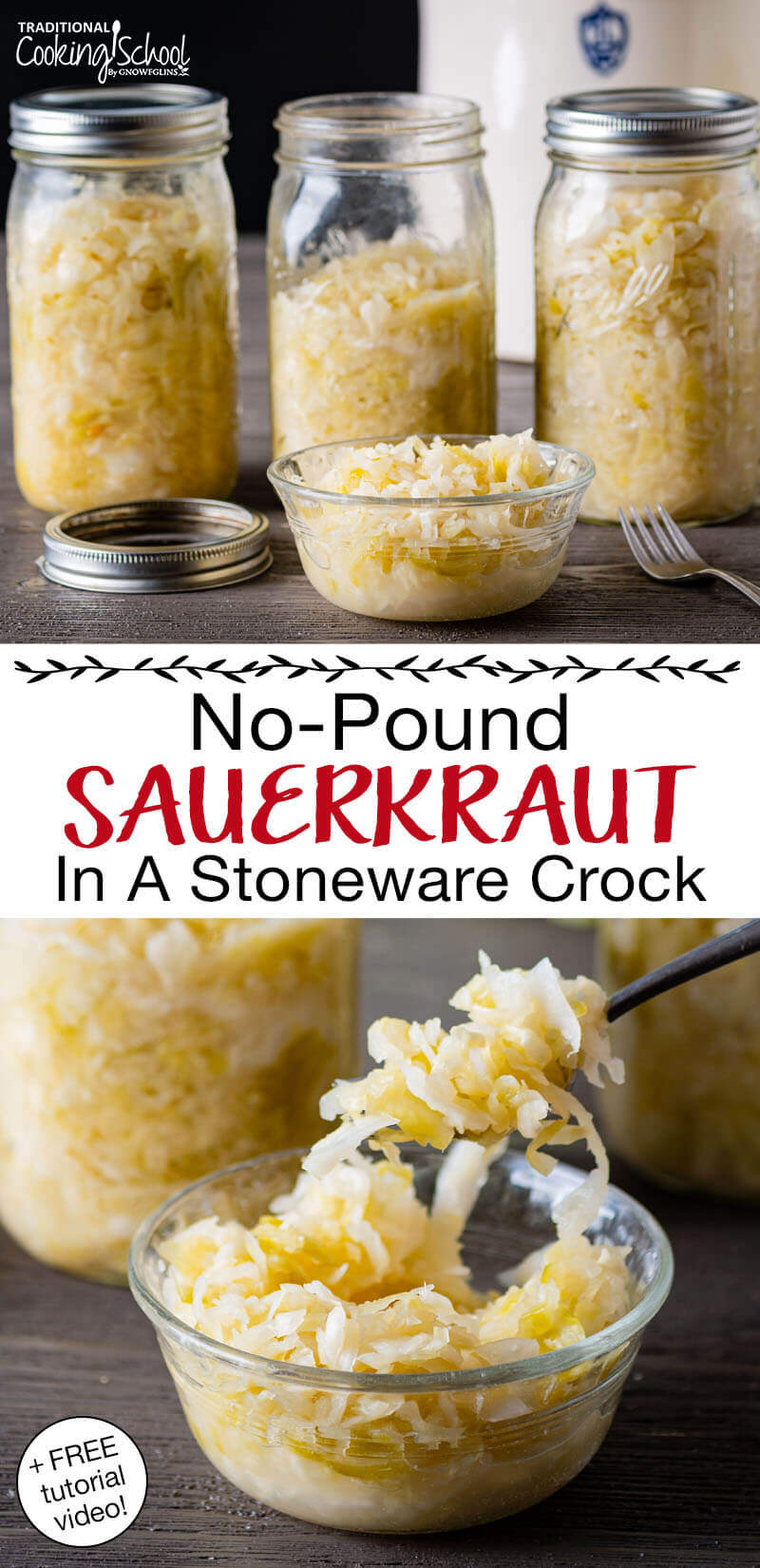
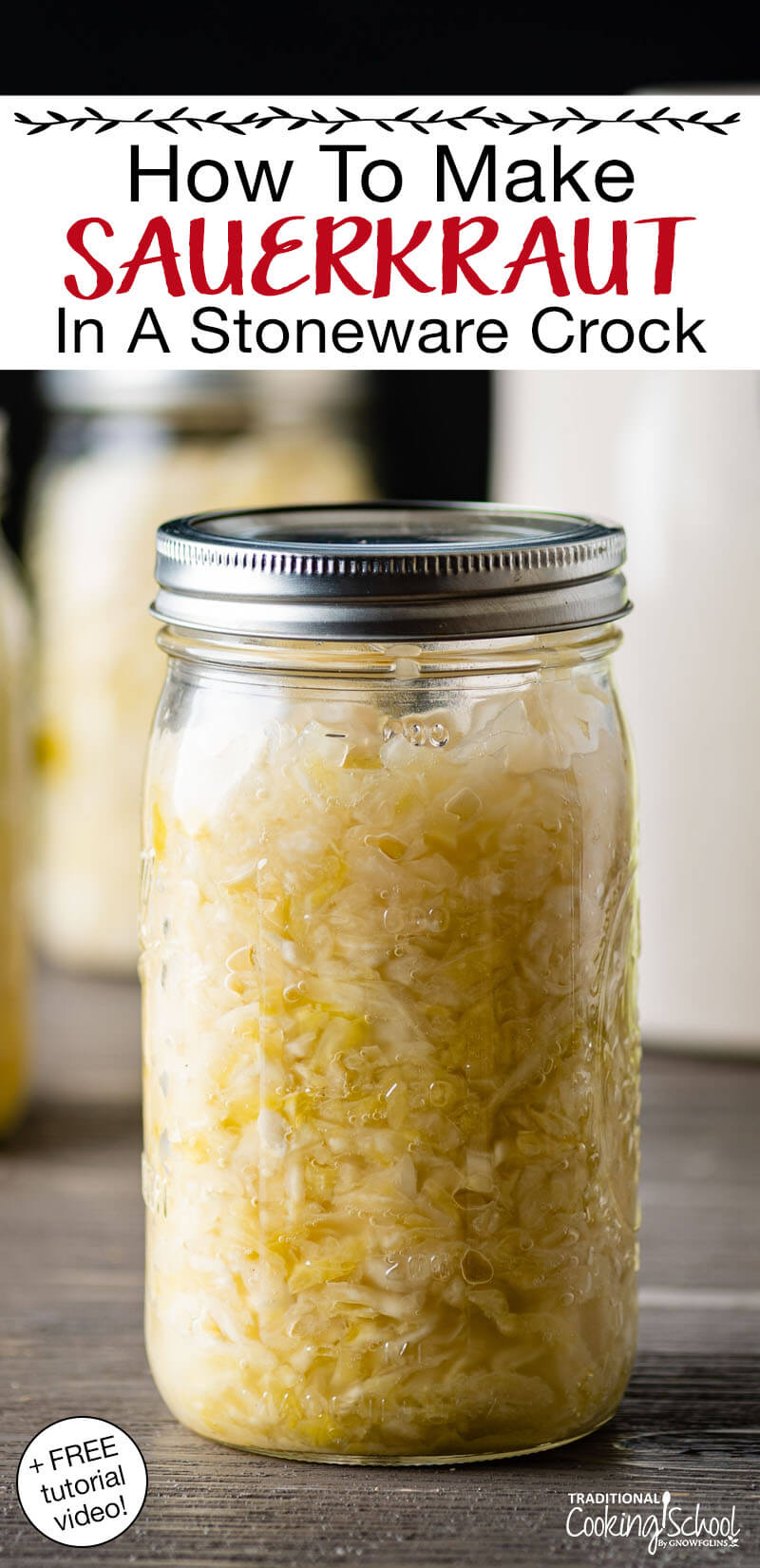
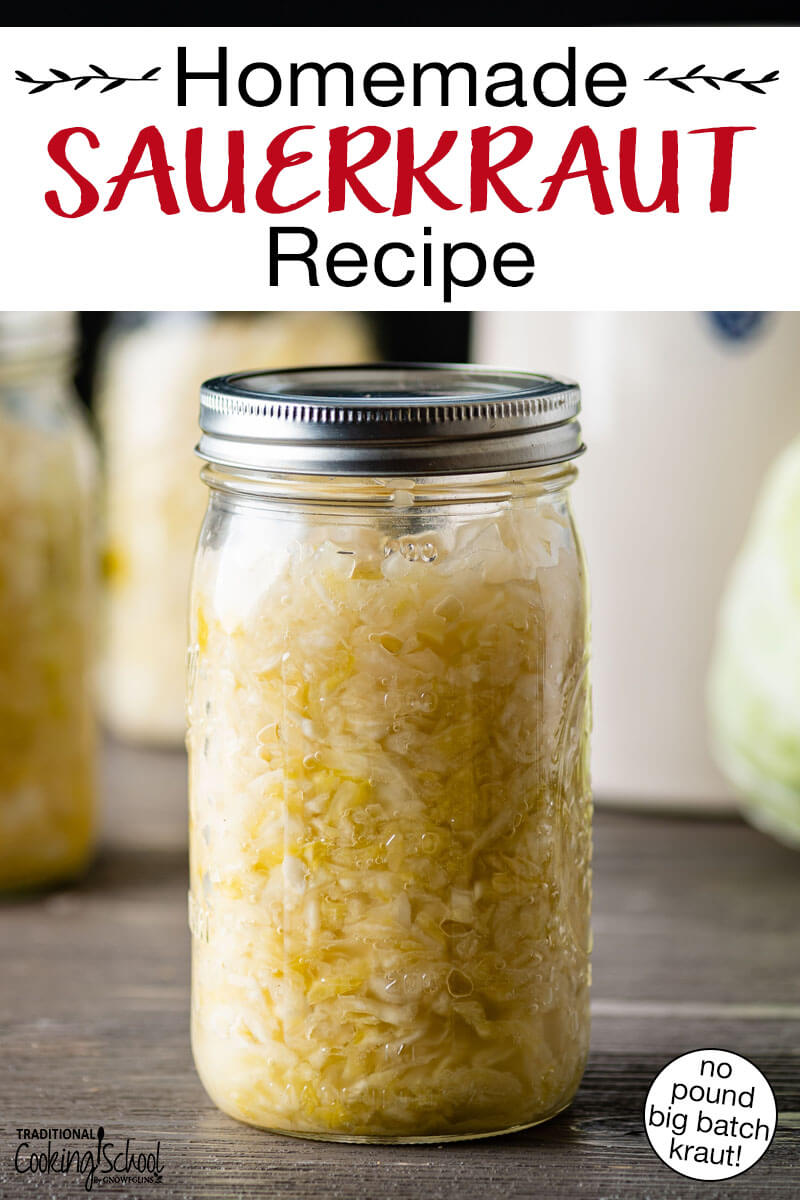

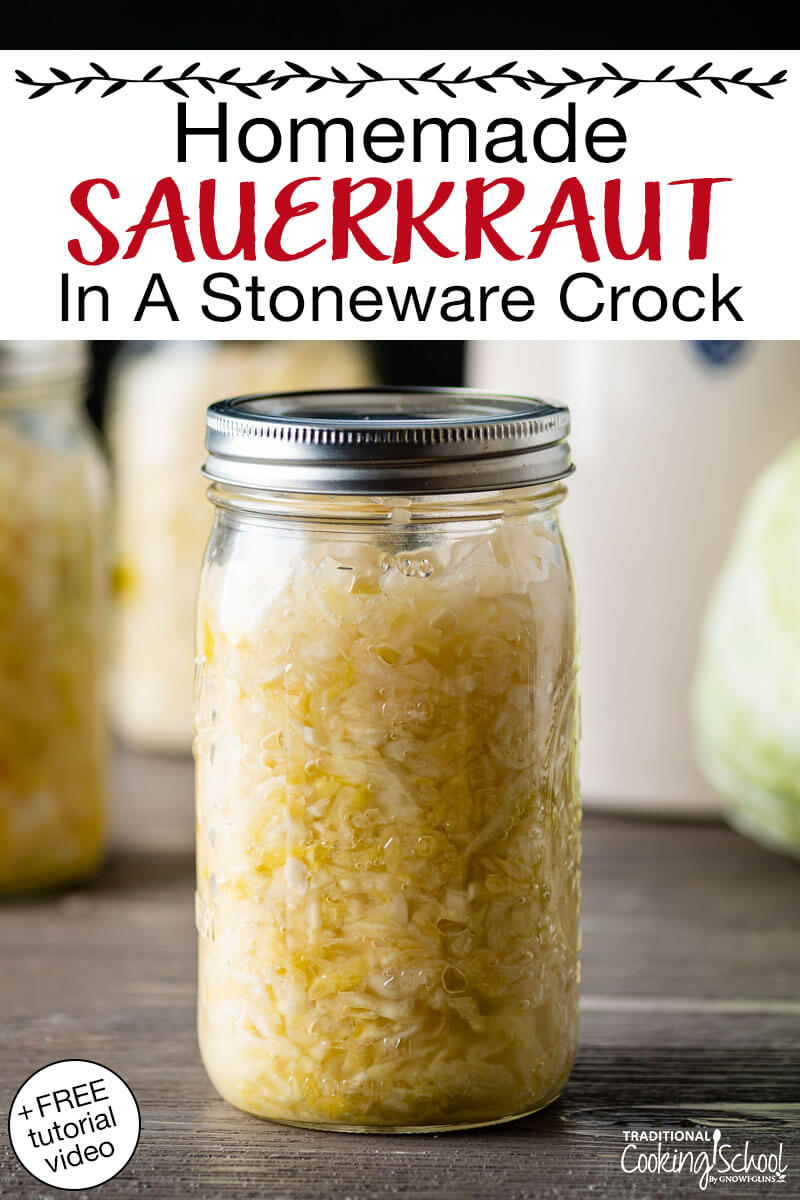
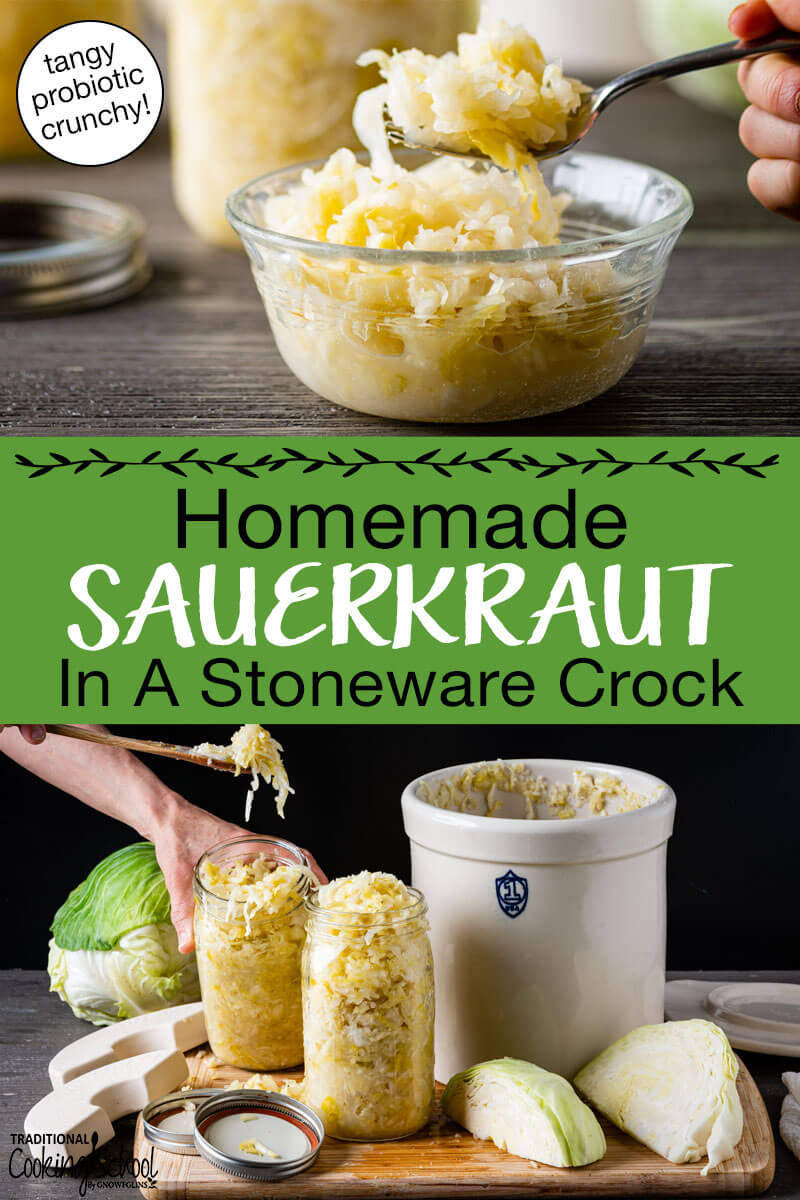
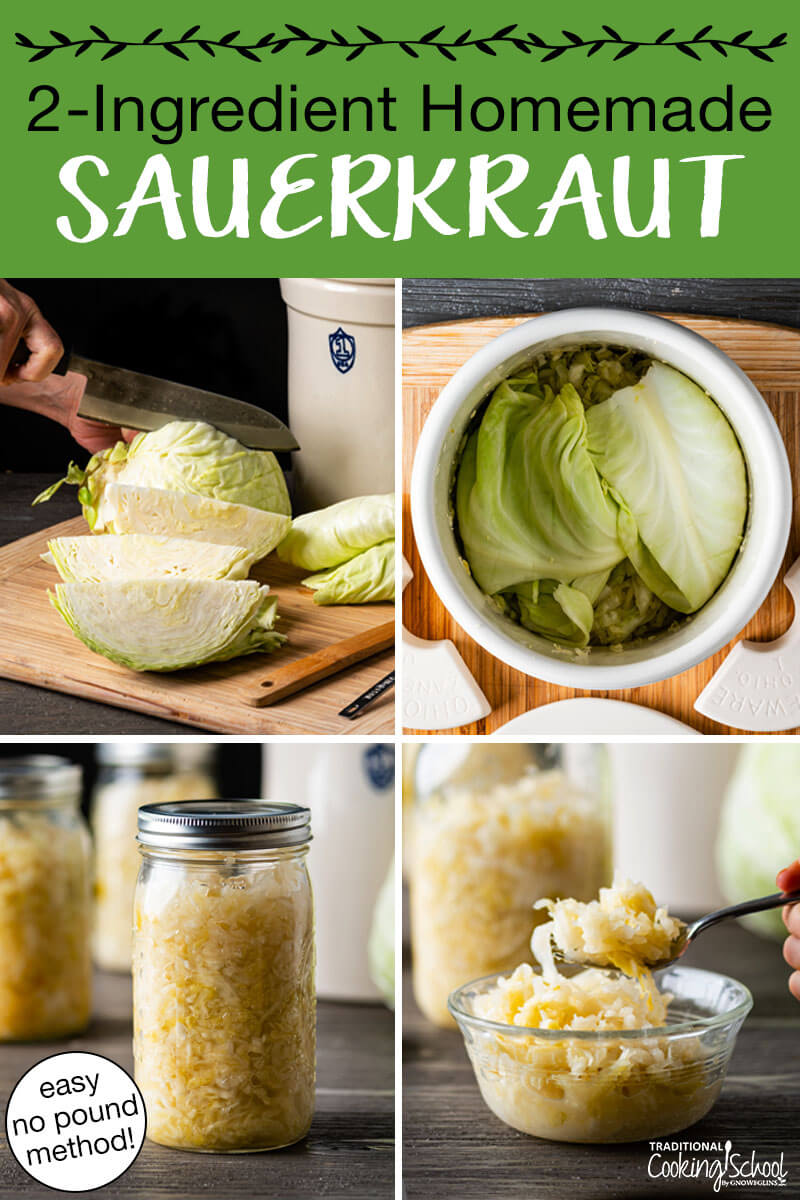
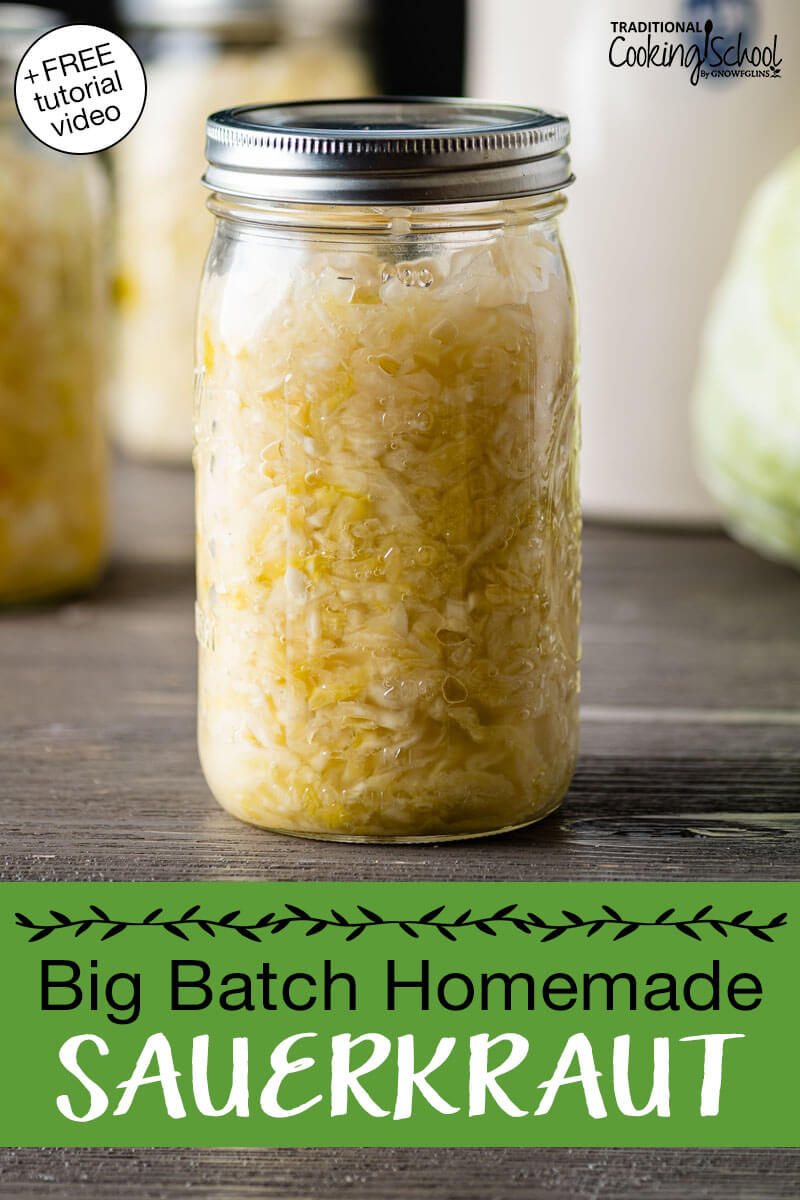
I ferment my kraut in a water ring german crock. I love it. I left my last batch in there for 7 weeks, as per one recipe I was following. It was so awesome! I sent a jar to my sister to try and her and her friend finished it in a couple of days! They asked why it was so crunchy and if it was supposed to be that way. I told her that when lacto-fermented, veggies don’t get as soggy as the canned stuff you buy at the store. So now she is looking for some cheap crocks so that I can come make some for her in quantity! I bought your book, and love it! Thank you for your classes and informative blog and website. I’m so glad I found you. I have touted your praises at my local Ladies Homesteading Group (LHG) Meetings. LHG is a nationwide membership group for ladies of like minds to get together to share ideas and help on homesteading, rural or urban style. We have monthly meetings for our local chapters where we learn to ferment, can, make sour dough, forage, garden, prevent pests naturally, etc. Members mentor each other in areas they have knowledge and we have meetings on knitting, quilting etc. So, now some of those members might be looking to you for information! Thanks for all you do!
<3 I will be looking for the Ladies Homesteading Group (LHG) Meetings you mentioned above!! Thank you!! I loved the video on Sauerkraut! Thank you Wardee, great job <3
Did you do anything special when putting in Mason jar.
Sorry, but I was unable to find a way to make a comment on this blog so I was forced to reply to your post. Maybe it’s just too complicated for an old person.
I wanted to ask Wardee is she could give us the correct amount of salt to use per pound of cabbage to make it easier to calculate.
Also , if we need to add salt water to the crock or to the storage jars in order to make sure the cabbage is covered what is the formula for the brine.
Apparently, it is important to have the correct ratio of salt to cabbage and salt to water in order for this process to come out correctly..
Hi, George: Someone else asked about making extra brine in the comments, too: Here is the recipe: 1 teaspoon salt to 1 cup of water. Add as much as you need to the batch or your jars. Also, 3 tablespoons per five pounds works out to be just under 2 teaspoons per pound. —Sonya, TCS Customer Success Team
I plan on trying your recipe to make sauerkraut in a crock. How long will the finished product keep in cold storage? Thank you.
Hi Richard,
Your kraut should keep for several months in cold storage. You may notice it start to lose it’s crunch. If this happens it’s time to consume. 🙂
Millie
Traditional Cooking School
Millie, thank you so much for this information.
My Kraut is still crunchy after a year in the refrigerator
Mine too, in fact I just finished mine up after a year in there!
Mine too, in fact I just finished mine up after a year in there!
There are some lead strips available to test the lead in older crockpots, and are available through local hardware stores.
I have a large crock with a lid that I place water on top of to prevent air entering the crock. The last two batches have not turned out. I did not test either for 3 weeks and was very disappointed when they were bad. I thought possibly I used too much salt or our home was too hot. I will try your recipe and taste it sooner.
Also, I find my weights get a little smelly. Last time I used mason jars filled with water to weigh it down. How do you clean the weights?
Thanks for all your podcasts and videos!
Lisa
Hi Lisa,
To sterilize, boil for 2 minutes. Wardee usually washes in soap and hot water though. 🙂
Millie
Traditional Cooking School
Just found your site today. I’m very excited to join your Traditional Cooking School. I’ve been waiting for the right fit for me and have searched several other sites in this field. I love simplicity and of course reasonable costs. On a personal note…..I was planning on learning how to make cheese at this time but I decided to breed my goats in a couple months and wait until next spring. I had just decided last week to begin learning fermentation beginning Sept, so the timing in finding your post on my FB via a friend is GREAT. Thank You so much for sharing your time and talents with us.
Thank you for the info about the USA made crocks; they’re beautiful. Unfortunately I already have the big, brown German version—functional, but not exactly aesthetically pleasing.
You mentioned that you allow to ferment for 5 to 10 days. I’m surprised at this small amount of time. I usually have to go 4 to 5 weeks.
Elizabeth ~ The big brown crock is legendary. I have a similar one in a 3-quart size from Ohio Stoneware. The nice thing is you get an air-tight seal. Enjoy!
Yes, I fermented for a month
It must be in my stars to make kraut! Before I came to my email, I just watched your video on Face Book and low and behold here is the same recipe in my email. That’s it I’m headed to the market to get a cabbage cause I love some homemade kraut but never have tried it. Can’t wait for the weeks to be done.
Thanks for posting twice for me, but in different areas!
Wardee, we make sauerkraut almost in this exact same way — but much faster, simply by juicing a small head of organic cabbage separately, putting the resulting juice in the jar with salt, shaking it hard to thoroughly mix, and then pouring this cabbage-brine over the salted shredded cabbage without any additional elaborate packing necessary. With the weights the shredded cabbage is completely submerged without any further ado. We’ve also switched from using traditional crocks altogether (after investing in 1 gallon, 3 gallon, and 5 gallon crocks plus the fancy German one) in favor of the “Crazy Korean” -brand .9 gallon BPA, DEHP and lead-free fermentation containers: they’re light, fit in the door of the refrigerator, and have a very unique air-lock system that guarantees that fermenting foods will stay completely submerged without the traditional weights. With these new containers we’re able to run seperate batches of ‘kraut, kimchi, cortido, and ginger carrots all at once first in the pantry and then store them in the refrigerator later in less than the room it would take for a single gallon crock!
Chris…where did you get the large German Crocks?
On Amazon, see http://www.amazon.com/gp/product/B00JG77G8M/ref=oh_aui_search_detailpage?ie=UTF8&psc=1 — although I’ve found the Korean ones to be a lot more practical, you can see them at https://smile.amazon.com/gp/product/B00M40ANMO/ref=oh_aui_search_detailpage?ie=UTF8&psc=1 if you’re curious.
I have a #8 grey crock- that is shiny- how do I know if it has lead paint?
Hi, Deb,
You can check with the manufacturer and here is a great resource page you might find helpful. Visit Lead Safe Mama for gobs of test results on vintage and modern kitchen items: http://tamararubin.com/
~Peggy, TCS Customer Success Team
We made kraut this year for the first time and couldn’t wait till it was done. We scalded everything we used, weighted it down and layered shredded cabbage and salt until it was submerged but it molded while I was on vacation during the 3rd week. And I’m not talking about small mold this was big ugly shaped mold oddities about the size of a small orange. It was in my very small pantry almost sitting on a a/c vent. I’m sure it was very cool. When we threw it away the kraut on the bottom looked perfect and smelled just like kraut but we were afraid to eat it with that mold floating on the top of the brine. I have never heard of this happening. My grandmother never had this problem. Any idea what we did wrong? We really want to try again next year.
Mary ~
Personally, I don’t prefer the multiple week ferments for this reason, especially with a container that’s open to the air.
As an alternative, why not ferment for 7 to 10 days out at room temperature, then move to cold storage to age for several more weeks there. That’s what I’d suggest.
I don’t think it’s necessarily that you did anything wrong over your grandma. Batches vary batch to batch, and there are intangibles that have effects ~ like local bacteria, mold in the house, detergent residues, cabbage crops, and even that A/C vent. 🙂
The krart was good’ I used to can 30 YEARS ago and I am doing it again. A western Virginian lady taught me. The first layer in the cock will be molded. About two inches. Just remove it and use the rest. Now I always pressure cooked canned it in mason jars to preserve it. I own one. A wise investment if you want to serve food safely.
Cooking will kill the bacteria, so the product will no longer be probiotic. Its being probiotic is one of the reasons people prefer home-made over store-bought (pasturized).
Yum… going to try this today…thank you Wardee!
Hi Wardee, A year ago I was delighted to find the benefits of Sauerkraut and made it twice. The second time, it stuck me that however less salt I add in, it is still salty and salt is something that is “less is more” I wondered if it is still all that beneficial.
Hi Sarah,
The salt is essential for fermenting safely and properly. A certain amount is required to protect the lactobacilli and repel spoiling organisms. If one reduces the salt, make sure to use a starter culture, and also don’t reduce too much!
Millie
Traditional Cooking School
Hello! I found your site via Facebook and was inspired to stay a crock of sauerkraut right away. I bought a 2 gallon crock at ACE Hardware, and started the cabbage Sunday morning. I think it’s going well now that I’m in day three, but I only have about a half inch of brine on top of the cabbage leaves. Do you think I should add some extra brine just to be on the safe side? Thanks!
When i make my kraut i shread a couple of carrots and i also add some juniper berries and some caraway seeds,about 2 tablespoons each.Turns out great
I just made a half batch of kraut today, according to your recipe. Do you think I might need to add water or salt water to get it to properly cover the cabbage?
Hi Vicki,
You do want the cabbage under the brine. If it’s not you can mix up more brine to cover.
Millie
Traditional Cooking School
If you have a juicer you can juice a cabbage, add salt to make a brine, and pour it over the ‘kraut. When I make cortido I use a combination of carrot, jalapeno, and cabbage juice for a brine, it works great!
I just purchased a German crock with the water seal..airtight. Directions say do not open the lid for at least 2 weeks. If the cabbage is covered with 1-3inches of water with an sir tight seal it shouldn’t loose water correct?
Hi Kathy,
That’s correct. No evaporation when it’s air-tight. 🙂
Millie
Traditional Cooking School
I have 2 – five gallon crocks, one old and one new. I would like to know why the old one has mold on the outside. These are stored in the cold elements.
Hi C,
We’re not completely sure but perhaps wasn’t cleaned well enough or something got on it. Or the environment was moist. Mold can develop in storage too. 🙂
Millie
Traditional Cooking School Support
When the Kraut gets to the point that you really like, can it be canned to make it shelf stable? We live in a hot climate and frig. room is limited.
Thanks, C. Manns
Please don’t can your kraut, canning will completely destroy the probiotic beneficial bacteria as well as most of the nutrients. Canned kraut is about as nutritious as soggy shredded paper, the high temperatures used kill everything that is good about kraut.
Hi Carolyn,
We have a great #AskWardee episode that addresses this: https://traditionalcookingschool.com/2016/08/24/does-canning-kill-probiotics-in-fermented-foods/
Here’s an excerpt from the article “Does Canning Kill Probiotics In Fermented Foods?
The answer is… it’s not pretty. Mostly, they don’t make it through the heat and/or pressure of cooking, much less canning or pressure canning.
The probiotics die. The enzymes expire. Many vitamins are lost.
(The minerals are ok. The acids should make it.)”
Millie
Traditional Cooking School Support
What a great idea! I’ve never thought of using a crock to make my sauerkraut – I always use mason jars of varying sizes. This is an interesting way (great way) to make larger batches! Your recipe also looks great, I’ll be happy to give it a try the next time I make my own sauerkraut! Thank you for sharing!
Trying a batch right now in a crock taken from an old crock-pot cooker.
When I buy good quality sauerkraut, the slices of the cabbage are thin and relatively uniform.
Now I want to make sauerkraut using your recipe. But, do you just use a big knife and just cut as thin as you can without hurting yourself? I don’t think a mandolin will work. Any suggestions?
Hi Jerry,
I slice mine as thin as I can without hurting myself. 🙂
I fell like, for us, the mandolin would be too fine.
~Danielle, TCS Customer Success Team
i have been making kraut for 60 years. i use an old 6 gal. crock. i cut the cabbage w/knife by hand. after it stops working i freeze it. this way you can keep it for a year. also it doesn’t lose its crunch. hope this helps.
I didn’t see how much salt to use in crock make up water for sauerkraut ?
Hi Chris,
Our Fermenting Cheat Sheet has a recipe for basic brine. You could use this to make up additional brine as needed. Here’s the link to request the Cheat Sheet: https://traditionalcookingschool.com/lp/lf-formulas-free/
Hope this helps!
~ Millie, TCS Customer Success Team
the first time I made kraut in my airlock crock it turned out perfectly. for the second time now i’ve just opened a batch and it was almost dry. very little liquid no mold. tastes ok but not like first one. i want to keep it and wondered if i can add brine and ferment more or put in the fridge? Help!!
Patricia,
You can definitely put a little more brine over the top to cover. You can do this any time you feel it’s a little dry. Whether it’s still fermenting or it’s already in cold storage. I hope this helps!
Our sauerkraut turned out well. It has been in the crock for 3 weeks. We stir it and chang the cloth nightly, put a 4 litre jug of water as a weight overtop a plate to keep it submerge under the liquid and put a rubber seal top over the crock. We were going to can it in the pressure cooker to last the winter but you have said this kills all the good probiotics, enzymes and many of the minerals. Perhaps we should freeze though I hate to use all that freezer space. So, does the store bought sauerkraut in sealed jars lack the probiotics and enzymes?
Hi Mary,
I’m so glad that your sauerkraut turned out well.
Yes, the high temperatures involved canning will kill the probiotics and enzymes. Store bought sauerkraut also lacks the probiotics because of the canning process.
You could freeze it but the texture of your kraut may change during the freezing and thawing process. Try a small amount first to see if you like the texture.
The best way to keep your kraut is in cold storage; your refrigerator. It can last up to a year. Try repacking in mason jars to put in cold storage.
~ Vicki, TCS Customer Success Team
I’m trying this for the first time and I’m not sure about the weights…I’m going to be improvising. Once the water has risen above the cabbage do I leave the weights there? Do I leave the weights in place even when I switch from room temperature to cold storage? Thanks to anyone who sees this and can advise!
Hi, Shannon,
You want to make sure the cabbage is covered during fermentation, the weights are to be left until it is done fermenting. Once it is done you can take the weights out and store in the refrigerator. I can’t wait to hear how it goes! 🙂
~Peggy, TCS Customer Success Team
many thanks!
I shopped for a crock to make sauerkraut. They all seemed rather expensive, and then I realized I have a large crock that is from an old crock pot cooker that is no longer working. The crock pot from the cooker works perfectly–just put a saucer over the cabbage and weight it down, and of course cover the whole thing with a cloth.
A large head of cabbage fills my crock about half-way.
These crock from old slow cookers are easily available at thrift stores.
Hi Larry,
What a great idea! Thank you for sharing.
~ Vicki, TCS Customer Success Team
What if I only had enough cabbage to fill the crock half way? Is that fine or does so much extra space in the crock affect fermentation?
Hi Amber,
As long as the cabbage you have is fully submerged it’s okay that you can only fill the crock half way. 🙂
~Danielle, TCS Customer Success Team
Hi, I’m wondering if I could do this same thing in an old ceramic crockpot insert with glass lid? And just buy some weights. Or would this not be sealed well enough?
Thanks in advance.
Hi, Amber,
You could possibly use this. If you are concerned about unwanted critters flying in then use a cheesecloth or a cloth of some kind (because if her crockpot is like mine the lid has small gaps) over with the lid on. You do not want it completely sealed off because of the gas it creates while fermenting will need to escape and you for sure would want some weights to keep it below the brine.
~Peggy, TCS Customer Success Team
My husband just followed all your directions and made your sauerkraut recipe. It is now sitting and fermenting. We’ ll You know how it turns out.
Following the instructions from the state university co-op extension, I weigh my kraut down with a brine-filled plastic bag. Since that means the plastic is touching the kraut, do you think the use of a plastic bag is safe? Or, should I be concerned about chemicals leaching into the kraut? Thanks.
That’s a creative idea, Debbie, but you’re right. You probably don’t want the plastic coming into contact with your sauerkraut. Another idea might be to place the plastic bag (filled with water or brine) on top of a small plate or saucer that could serve as a barrier between the bag and your sauerkraut and still weigh it down.
Sonya, TCS Customer Success Team
I just made a batch of souerkraut from a similar recipe using just salt, but I didn’t use leaves to top it off. I did use the weights. After a few days everything looked good, all was under a small amount of brine, so I left it to sit for the remainder of time. I came back to “beautiful” white fuzzy mold-y stuff. I pulled up the weights and the whole thing of mold came up. It smells wonderfully like kraut but wonder if it’s safe to eat. I did notice the brine was no longer over the top of the cabbage but it was not dry, still moist. So, is safe to eat? Thanks
Hi, Margaret,
Your kraut may be safe to eat. 🙂 Wardee has a great article on this:
https://traditionalcookingschool.com/food-preparation/troubleshooting-ferments-kyf172/
~Peggy, TCS Customer Success Team
Thank you! Very helpful.
If I cook the finished kraut in some dish, will I lose the live probiotics?
Hi, Connie,
Yes, if you cook your kraut you will lose the live probiotics.
~Peggy, TCS Customer Success Team
I’m not making the sauerkraut for the probiotics (although I do appreciate that aspect), I’m making it because I’m German and want to learn to cook more foods in my tradition. That being said, is it okay to can some of this? I just don’t have refrigerator space to hold the completed kraut.
Thanks much, lois
Hi Lois,
If you’re not interested in the probiotics in the sauerkraut you can can it. Just know you will kill the probiotics during the canning process.
Please follow a recommended canning process for canning the sauerkraut.
~ Vicki, TCS Customer Success Team
Hi, I’m thinking of making a batch of sauerkraut in a 3 gal stoneware crock
( Medalta Potteries, Redcliff, ATLA Canada ). I have a 11 lb cabbage, I would like to make sauerkraut with, can I use canning/pickling coarse salt instead of the sea salt? and is it the same amount? also, should I cover the crock with cheese cloth as well as the lid?
Years ago I made cabbage kraut in the same style crock stated above but in a 5 gal size and the batch went bad, (liquid turned to slim)?? I’m still afraid that may happen, again! a shame when you put all that effort into growing your own vegetables/cabbages to see it all go to waste.
My second thought is to make the kraut in a glass jar.
Just recently, I made turnip kraut in a large glass jar, and was a success! maybe small batches are better?
I just read the post from Sept 2018, Larry Bierman… mentioned he decided to use a slow cooker crock as the regular fermenting stoneware crocks being too expensive. I may give that a go myself, thanks Larry.
Thanks Wardeh for your info on making sauerkraut in a crock, I might just give the larger crocks another try. Maybe
And thank you Millie
“”””””””
Hi, Sherry.
Yes, you can use pickling/coarser salt. Same amounts, maybe slightly more if you’re using coarse salt.
The slime can come from a warm-temperature, low salt environment so too little salt could have been the issue. Salt keeps the
I make my kraut in glass jars. It’s a great option. 🙂
~Danielle, TCS Customer Success Team
If I have to make more brine , should it be room temp. Before I add it to fermenting stage?
Roughly room temperature is good, Barbie. 🙂
~Danielle, TCS Customer Success Team
I never get enough brine. suggestions?
Hi, Mavis.
You can make extra brine with salt and water if you need to.
1 tsp salt to 1 cup of water. Add as much as you need to the batch or your jars. 🙂
~Danielle, TCS Customer Success Team
Hello, I tried making a small batch with the 3/4 of a head of cabbage I had, in a 2 gallon container. It’s sat overnight and is quite wet but not sitting under 1″ of liquid. It smells just like it should.
I’m wondering if I can save this by adding some liquid or if I am headed for trouble and should just discard it.
thanks.
Hi, Carrie! You can totally save it by adding some brine! Just keep an eye out for mold, but I think you’ll be fine. —Sonya, TCS Customer Success Team
I have little mold can I take it off and be good?
Hi, Genia,
You will find this post helpful on molds, it’s listed as #4:
https://traditionalcookingschool.com/food-preparation/troubleshooting-ferments-kyf172/
~Peggy, TCS Customer Success Team
It’s been about 24 hours and there is hardly any liquid. Suggestions or just wait. It has shrunk to about half full in the crock.
Hi, Jean: I’m happy to help! I would top off your sauerkraut with some brine. Here’s a link to Wardee’s brine recipe: https://traditionalcookingschool.com/food-preparation/how-to-prevent-mold-during-fermentation-aw074/ You don’t want any mold to form, and it might if the sauerkraut is not kept submerged under the fermenting liquid. Do you have a small plate you can place on top with some weight added to keep the sauerkraut below the liquid? —Sonya, TCS Customer Success Team
I have 4 red cabbages, about 5 lbs each. will these work for sauerkraut?
Absolutely Richard! ~ Vicki, TCS Customer Success Team
Thanks a bunch.
I’m using up a cabbage I didn’t feel like cooking.. it’s too hot to cook..
I will be trying it soon. Thank you for sharing. I look forward to seeing more of your recipes.
Hi, I recently blanched a lot of cabbage for the freezer. Do you think that the beneficial nutrients were killed by the blanching, or will it be fine for making kraut? Thank you!
Hi, Jeanetta.
Blanching may have an impact on lactic acid production during fermentation. It could slow it down or encourage mold growth, I can’t say for sure.
If you want to use it, be sure you are adding salt and mix raw cabbage with the blanched.
~Danielle, TCS Customer Succes Team
I don’t think this is going to work. It’s been three days, no liquid yet. I had to put in over a cup of water and 3 Tsps. of 100% Sea Salt. That only brought it to the top of the already tamped tight, cabbage leaf-covered, and weighted.
It’s my first time. I followed the recipe to the tee, (Gallon and a third crock). The huge head of cabbage only filled it, less than half. Now what, start over?
I suggest you give the approx. number of cabbage heads it may take to bring the kraut to the proper level! I thought one huge head would be more than enough. Looking like four might do it.
I wish I had watched my grandmother closer but, I didn’t like sauerkraut as a kid.
I was so looking forward to homemade kraut next week!
Hi, Walt,
As long as there is brine covering it should be ok. It’s hard to give exact amount of cabbages because of the size and weight. Some cabbages have more water in them than others and produce a lot of brine. It could be the temperature in your home that slows it down as well. Some of my ferments happen very quickly and some more slowly. Keep an eye on it to make sure to add more brine if necessary and taste it after a week. You also might find this helpful, don’t give up, its the best sauerkraut: https://traditionalcookingschool.com/food-preparation/troubleshooting-ferments-kyf172/?_rt=MXwxfGZlcm1lbnQgc2FsdHwxNjQzODMxODk3&_rt_nonce=70e62b0b20&swcfpc=1
~Peggy, TCS Customer Success Team
This is my first time making homemade kraut. I’m so excited I ran across your video. I’m waiting for my crock, stone weights and lid to arrive. My background is German and I can’t believe I’ve never made kraut. I’m getting pretty tired of the commercial brands. I’m hoping it works out well and if it does, I’ll be making more. Thank you for your great video.
Hi! I just tried this for the first time. I used a glass jar. I was barely able to get all the cabbage in my jar, I had to pack it down so tightly, and it went right up against the lid. I let it ferment for about 3 1/2 days, but the upper 1/3 of the cabbage has turned just a little tan color. It smells and tastes fine, like nothing is bad. Do you think it is alright? Also, can I make coleslaw with it? Thank you!
Hi, Jeanetta,
I would be careful not to fill your jar too full, 1 inch of headspace on top is recommended, and sometimes I do more along with a weight to keep the cabbage down. Sometimes it pushes it up and I push it back down. You want to keep it below the brine. If your cabbage smells fine and tastes fine it should be ok, make sure to store it with brine covering it so it stays fresh longer. Let us know how the coleslaw turns out.
~Peggy, TCS Customer Success Team
I Loved you Video, this is my first real try. Two days ago I attempted to make a batch but only had a half head of Cabbage, ? it only made a Alf jelly jar full!
After fermenting the Sauerkraut, how do you proceed to Can it. Do you need to top each jar off with Brine?
Thank you, Merilee
Hi, Merilee.
It’s possible you need more cabbage depending on how big the head was.
Please see points nine and ten above regarding brine and storage.
~Danielle, TCS Customer Success Team
I have a 2 gallon fermenting crockpot from Ohio stoneware. Website claims pots are lead free but says nothing about them being cadmium free. The pot is brown inside and I read that the shinny brown glaze is made with cadmium being added to it. Do you know anything about this? I worry about cadmium leaching into my ferments.
Hi, Kate.
We have not heard that their products contain cadmium. I recommend reaching out to them directly.
~Danielle, TCS Customer Success Team
Excellent post
Hello, I am making my first batch of sauerkraut in a 2 gallon crock. I followed the recipe and filled the crock most of the way up with 3 heads of shredded cabbage and about 5 teaspoons of canning and pickling salt. I packed it tightly, placed weights on top and covered with a heavy towel. I don’t have a seal-tight lid. Will this still work and ferment as it should? Thanks for your helpful recipe and directions.
Thank you for sharing this recipe. I love to bake from scratch, I make sourdough. My husband was an awesome cook. So I am learning how to cook like he did. He passed away a few months ago. I love sourkraut & kielbasa. For that reason I will buy a crock & make it from scratch. I’m all about going old style in almost every sense of the word.
This looks amazing! I love the idea of making sauerkraut at home, especially in a traditional stoneware crock. Can’t wait to try out the recipe and watch the video for tips. Thanks for sharing!